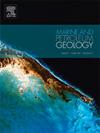沉积粒度特征影响下的深埋砂岩储层压实和孔隙保存机制:来自DEM模拟的启示
IF 3.7
2区 地球科学
Q1 GEOSCIENCES, MULTIDISCIPLINARY
引用次数: 0
摘要
深埋砂岩储层的压实和颗粒破碎作用对储层物性演化起着至关重要的作用。不同沉积粒度特征的储层压实行为和孔隙保存存在显著差异。然而,缺乏对这些过程的定量评估和机制研究。本研究利用离散元法(DEM)模拟两组不同粒度分布的样品,探讨压实和孔隙保存过程。A组样品表现为单峰高斯GSD,中位粒径(Md)逐渐增大,而B组样品具有相同的Md,但GSD类型不同。结果表明:随着应力的增加,试样经历了3个压实阶段:晶粒重排(S1)、强GC -重排(S2)和弱GC -重排(S3)。S1中颗粒重排,滑动最小,无GC,孔隙损失率低(Δϕ/Δσ)。S2阶段GC增强,碎片滑动填充颗粒间孔隙,导致Δϕ/Δσ显著增加。在S3中,高配位数降低了GC,小孔隙限制了碎片的移动,导致Δϕ/Δσ减小。Md对S1中的Δϕ/Δσ没有影响。而Md越小的样品GC越弱,孔隙尺寸也越小,使得碎片在S2过程中更难填充孔隙。在S3中,具有较大Md的样品具有较高的配位数,从而提供更强的GC缓冲,从而降低Δϕ/Δσ。此外,GSD在S1期间不影响Δϕ/Δσ。S2中,粗偏双峰高斯GSD的样品GC较弱,孔隙大小和碎片大小的差异较小,因此相对较低的Δϕ/Δσ。因此,在深埋条件下,粒度小、粗偏双峰GSD的砂岩抗压实能力强,孔隙保存效果好。本文章由计算机程序翻译,如有差异,请以英文原文为准。
Compaction and pore preservation mechanisms of deep-buried sandstone reservoirs under the influence of sedimentary grain size characteristics: Insights from DEM simulations
The compaction and grain crushing (GC) of deep-buried sandstone reservoirs play a crucial role in the evolution of reservoir quality. Significant differences exist in the compaction behavior and pore preservation of reservoirs with varying sedimentary grain size characteristics. However, there is a lack of quantitative assessments and mechanistic studies of these processes. This study utilizes the Discrete Element Method (DEM) to simulate two groups of samples with different grain size distributions (GSD) to explore the processes of compaction and pore preservation. Group A samples exhibit a unimodal Gaussian GSD, with the median grain size (Md) gradually increasing, while Group B samples share the same Md but differ in GSD type. The results indicate that with increasing stress, the samples undergo three compaction stages: grain rearrangement (S1), intense GC and rearrangement (S2), and weak GC and rearrangement (S3). In S1, grains rearrange with minimal sliding and no GC, resulting in a low porosity loss rate (Δϕ/Δσ). In S2, GC intensifies, with fragments sliding and filling the pores between grains, leading to a significant increase in Δϕ/Δσ. In S3, a high coordination number reduces GC, and small pores restrict the movement of fragments, resulting in a decrease in Δϕ/Δσ. Md has no effect on Δϕ/Δσ in S1. However, samples with smaller Md experience weaker GC and have smaller pore size, making it more difficult for fragments to fill the pores during S2. In S3, samples with larger Md have higher coordination numbers, providing stronger buffering against GC and resulting in lower Δϕ/Δσ. Additionally, GSD does not affect Δϕ/Δσ during S1. In S2, sample with a coarse-skewed bimodal Gaussian GSD exhibited the weaker GC, smaller difference between pore size and fragment size, resulting in a relatively low Δϕ/Δσ. Therefore, under deep burial conditions, sandstone with small grain size and coarse-skewed bimodal GSD demonstrates strong resistance to compaction and effective pore preservation.
求助全文
通过发布文献求助,成功后即可免费获取论文全文。
去求助
来源期刊

Marine and Petroleum Geology
地学-地球科学综合
CiteScore
8.80
自引率
14.30%
发文量
475
审稿时长
63 days
期刊介绍:
Marine and Petroleum Geology is the pre-eminent international forum for the exchange of multidisciplinary concepts, interpretations and techniques for all concerned with marine and petroleum geology in industry, government and academia. Rapid bimonthly publication allows early communications of papers or short communications to the geoscience community.
Marine and Petroleum Geology is essential reading for geologists, geophysicists and explorationists in industry, government and academia working in the following areas: marine geology; basin analysis and evaluation; organic geochemistry; reserve/resource estimation; seismic stratigraphy; thermal models of basic evolution; sedimentary geology; continental margins; geophysical interpretation; structural geology/tectonics; formation evaluation techniques; well logging.
 求助内容:
求助内容: 应助结果提醒方式:
应助结果提醒方式:


